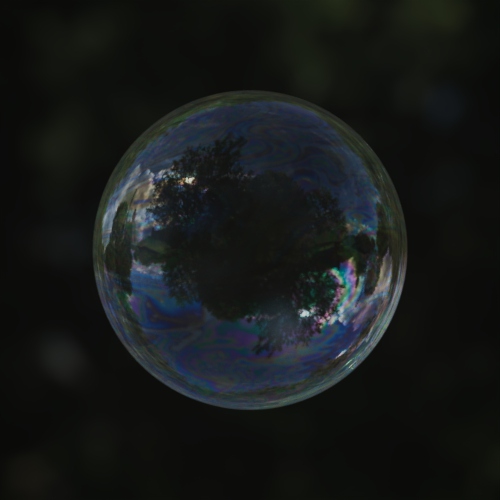Thin Film - Arnold User Guide
 |
 |
| Without thin film | With thin film |
Thin Film reproduces the effect of iridescence such as brightly colored fringes, due to wave interference within a layer of dielectric on the surface, of thickness comparable to the wavelength of light. It can be used for materials such as a soap bubble, burnt chrome, or the reflective coating on a beetle.
The assumed structure is as shown below, where the thin-film sits on top of the base (metal or dielectric), and beneath the coat. Thus, it is tinted by the coat color if present. The IORs of the film itself, as well as its adjacent media, affect the look of the fringes.

Though a soap bubble is technically a thin-walled structure, it can be modeled as non-thin-walled by making the interior dielectric have IOR 1, and applying the thin-film. The IOR for water is 1.33, and soap is about 1.5. Therefore, the IOR (of the thin film) for a soap bubble should be in the 1.33-1.4 range. A grayscale map should be connected (through a Range shader) to Thin Film Thickness if variation in the Thin Film is required. More information about soap bubble color and film thickness can be found here.

The Thin Film look is dependent on the Base Color (as well as the film IOR, Thickness and Weight).
Weight
Coverage weight of the Thin Film. This controls the overall blend of the color fringes with the other lobes, without affecting the fringe width or color.
 |
 |
 |
| 0 (default) | 0.5 | 1 |
Thickness
Defines the actual thickness of the film (in micrometers) between the specified min and max thickness (0 to 1 micrometer soft min/max). This mostly controls the spacing of the fringes.
This could be driven by something like a noise map to give some variation to the interference effect.
If the thickness becomes large (e.g., 3 micrometers), the iridescence effect will disappear, which is physically correct behavior.
 |
 |
 |
| 0 | 0.5 | 1 |
IOR
The refractive index of the thin film. This mostly controls the hue of the fringes.
 |
 |
 |
| 1 | 1.4 (default) | 3 |
